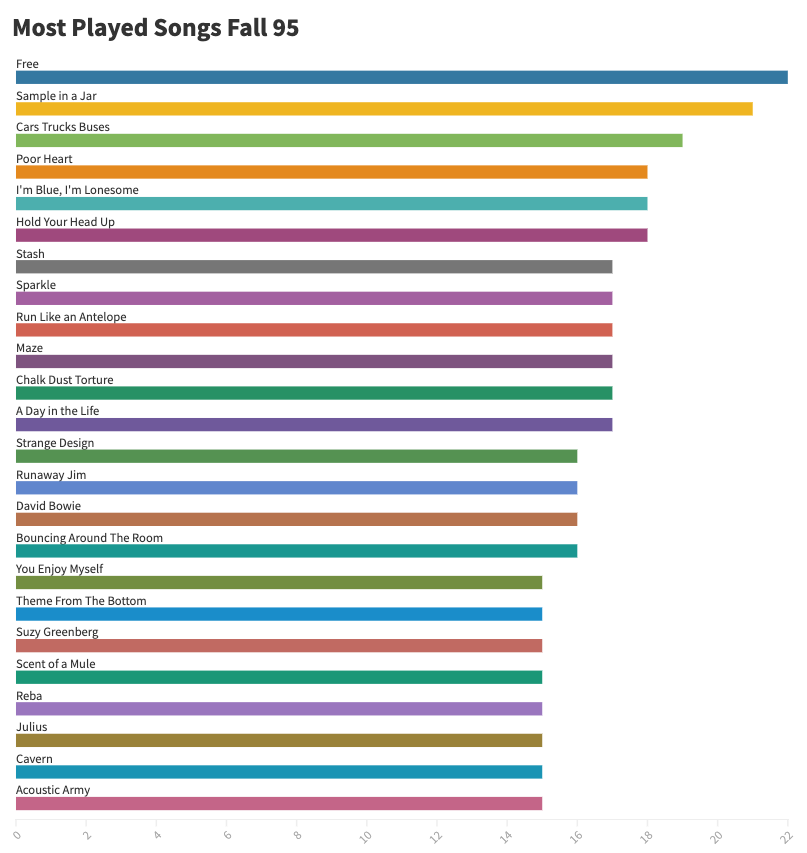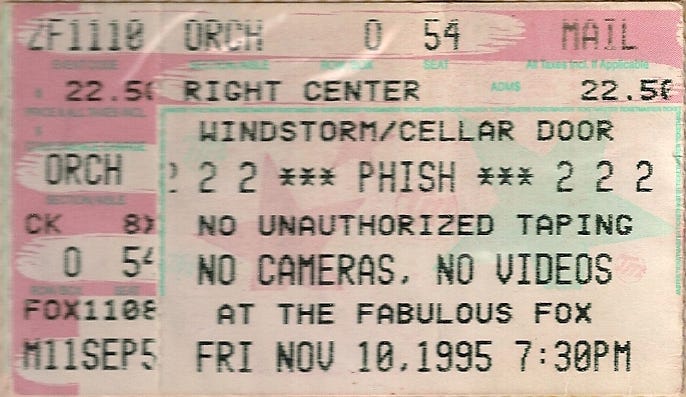SET 1: Bouncing Around the Room, Runaway Jim, Taste That Surrounds, The Old Home Place, It's Ice, Dog Faced Boy, Maze, Guyute, Cavern
SET 2: Free, Scent of a Mule, You Enjoy Myself -> Crossroads -> You Enjoy Myself, Strange Design, Sparkle > AC/DC Bag, Sweet Adeline
ENCORE: Harry Hood
The year’s only three-night stand — and a middle show which is very good, but the most mundane of the Atlanta run — provides an opportunity for some of my favorite Phish geekery: looking at the setlist rotation. As far as I’m aware, Trey is still writing out nightly setlists in advance in 1995, even if they didn’t always stick to them exactly once the show got going. So how they choose to divide up their current repertoire into three equal portions, without the complicating factors of travel or off-days between, is an insightful window into their priorities as early fall turned into late autumn.
In an era when Phish so rarely played multi-night runs, it’s a little hard to quantify exactly the mean rotation of the band’s catalog. Without getting too statistical, I’d put it somewhere between 3 and 4 shows — apart from brand-new material, you’re not likely to hear a given song in consecutive shows, or even twice in 3 shows, no matter how far the distance between venues. The last time Phish played a 3-show run, in May 94 at San Francisco’s Warfield Theatre, they just missed the no-repeats mark, playing Julius on the first and third nights. But with another 18 months of confidence, a fresh batch of material, and no new album to promote, the Fox Theatre run avoids repeats easily, suggesting they now have closer to 4 shows of material without doubling back.
Over at the eternally early-web aesthetic of International House of Zzyzx, you can find a dropdown to get the stats for Fall 95 overall (it’s so early-web that I can’t link it directly). Those numbers confirm my intuition, with only three songs in a three-show rotation, or topping 33%: Free, Sample, and CTB. For those averse to primitive HTML, I’ve made some pretty bar charts to show the songs played at least 15 times on the 54 shows of fall tour:
That list shows a mixture of new songs and covers (Free, CTB, Strange Design, ADITL, Theme), novelties (Blue & Lonesome, HYHU) and, shorter songs (Sample, Poor Heart, Sparkle) topping the charts — these are the backbone of your typical Fall 95 show. But the rotations fans cared about were the songs most likely to feature improv, which I’ve (subjectively) assembled here:
This one’s a little more interesting. Given that the once-every-four-shows boundary is 14 plays, it’s surprising to see some of the 90s staples below that mark: Possum, Melt, Mike’s/Weekapaug, and Tweezer were all less than 25 percenters during one of Phish’s most iconic tours. For wide-open Type II playing, your best bet was a Bowie, just a tick below one-third of shows, or perhaps YEM, sitting just above one-in-four.
Accordingly, both of those are the featured second-set jam on the third and second nights of the run, respectively. But there’s not really an obvious third jam vehicle in heavy rotation, which made for that interesting setlist on night one — the highlight, Gin, doesn’t even make any of these most-played lists, having only been played 7 times, or in 12 percent of shows. The jams are also starting to pop up in unexpected places; tonight’s YEM is pretty pedestrian compared to its previous iteration in Rosemont, with a Crossroads in the middle that already feels rote in its third appearance this tour, and instead it’s the late AC/DC Bag and the early first-set Taste that provide unexpected, if brief, fireworks, and Hood gets a rare encore appearance.
The third rotation angle I looked at was the shift between the first and second legs, as the band adjusts for what material plays to their developing strengths and the larger arena settings of the tour’s back half. The biggest gainers and losers are charted below:
The declining songs reflect a shift away from the more gimmicky side of the Phish experience. Both Armys drop in frequency, and the slight dip on I’m Blue, I’m Lonesome suggests that the acoustic bluegrass setup didn’t come out quite as much. Some of the new songs also lose their early-tour shine; Cars Trucks Buses was played almost nightly at the start of the first leg, and drops down to every 4 or 5 shows for the second, while the ballads Billy Breathes and Strange Design cool off slightly.
But it’s the gainers that say a lot more about Phish’s changing approach — OK, after you set aside Bouncin’, which seems to belatedly get “album single” status for A Live One, still less than six months old. Most of the songs after it on this list are meaty, offering jam potential (Hood, Gin, Mike’s, Tweezer), lesser-known composed epics (the very old Curtain, the very new Guyute), or songs with big riffs for big rooms (Simple, Julius, and Tweeprise, which humorously outpaces its parent by two clicks). Compare the two lists and you get the sense that Phish is dialing down the novelty and getting serious on the back nine.
That’s already in evidence at the Fox — there’s no acoustic bluegrass, despite the intimate environs, and they just barely get Acoustic Army in there in the final encore. While the first show dips in and out of peaceful moments throughout the night, the second and third nights are an escalating trend of energy, with second sets that pause for breath only briefly on Strange Design tonight and Sleeping Monkey tomorrow. It’s a place where the numbers and intuition align; whether it’s a three-show run or a one-off, Phish is dialed in.
[Charts made with Flourish. Stub from Golgi Project.]







